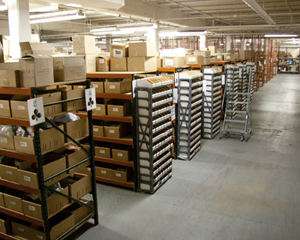 This is a question that many online sellers ask themselves, or may ask their third party provider if they outsource their order fulfillment. Unfortunately there’s not a straightforward answer, and whether or not merchants should utilize more than one fulfillment center is dependent on a number of factors.
This is a question that many online sellers ask themselves, or may ask their third party provider if they outsource their order fulfillment. Unfortunately there’s not a straightforward answer, and whether or not merchants should utilize more than one fulfillment center is dependent on a number of factors.
Let’s start by asking the question, why would sellers consider more than one order fulfillment center? The answer is faster delivery times, reduced shipping costs, or both. With reduced shipping costs comes greater profit margins for sellers, and generally the closer you are to your customers, the cheaper it is for you to ship orders to those customers. Shipping carriers, such as FedEx and UPS, break down the U.S. by shipping zones. The further the shipping location is from your customer, the higher the zone. The higher the zone, the greater the cost to ship the order.
By utilizing multiple fulfillment warehouses, sellers hope to save money by cutting down on high zone, high cost shipments. Another way to say this is that sellers are taking advantage of zone skip savings. In an eCommerce world in which buyers are increasingly expecting free or reduced shipping, multi-warehouse fulfillment is thought by sellers to be a great way to cut costs and better compete online. The problem is, it doesn’t always work that way.
Let’s take a look at 5 factors that online sellers should consider when debating multi-warehouse order fulfillment.
1. Number of Products
In order to fill eCommerce orders from multiple warehouses, sellers need to split inventory among those warehouses. The more products you have, the more costly this can get, and in many cases, the costs associated with doubling or tripling of on-hand stock inventory can completely wipe out any potential cost savings relative to multi-warehouse distribution. Sellers need a greater amount of working capital in order to increase inventory, and additionally need to factor in the cost of added labor and overhead, in the case of in-house fulfillment. The cost of added warehouse space should also be considered, which applies whether the seller handles their own fulfillment, or outsources it to a third party fulfillment house. On occasion it may make sense for merchants to only split their top selling products, and fulfill the remainder of their orders from one distribution center.
2. Number of Orders
Order volume is another consideration. Sellers should evaluate the volume of orders shipped, and do so by destination…more specifically, by shipping zone. As you do so, you can determine the number of orders that are shipped to higher zones, along with potential cost savings of cutting down those zones by adding another fulfillment center. If the volume of orders shipped to higher zones is not great enough, sellers will find that the added expense associated with multi-warehouse distribution will exceed the zone skip savings potential.
3. Order Weight
The average weight of your orders can also make a difference. The reason for this is that, if you ship lightweight orders, and many are delivered via USPS First Class or Priority Mail, the shipping cost savings associated with adding another fulfillment warehouse to the mix will be slim to none. In this case, the biggest benefit will be faster delivery times. If, however, you ship heavier orders, the zone skip savings potential is greater, if sellers have the capital and order volume to support it.
4. Order Destination
There are two types of orders to consider when it comes to destination: U.S. orders and international orders. When comparing the two, the shipping cost savings potential relative to multi-warehouse distribution is typically greater with international orders. Often merchants will sell a relatively low number of orders to many international markets, making it cost inhibitive to set up fulfillment centers in each of those markets due to low order volume. In other cases, however, merchants may have a primary international market they sell to, and the order volume may support adding a warehouse in that particular market. The other option is to consider a centrally-located fulfillment house. For example, at eFulfillment Service, our fulfillment warehouse is not only situated between the east and west coasts of the U.S., we are also close to Canada, making us a cost effective option for many merchants selling to both U.S. and Canadian customers.
5. Technology
Technology enables logistics. When it comes to eCommerce fulfillment, there are a variety of systems which need to communicate in real-time in order to effectively and efficiently fill orders. When more than one distribution center is added to the equation, it often becomes more complex. When products are sold through multiple channels, that adds another layer of complexity, and merchants may be forced to invest more heavily in technology to support multi-warehouse distribution, an expense that should be considered when conducting a cost/benefit analysis.
For many online sellers, when all of the costs involved are taken into consideration, the numbers simply do not support multi-warehouse distribution. In other cases, it does make financial sense, but to effectively evaluate your options, it’s important to have a significant amount of order history built up. That way, merchants are able to forecast sales more accurately, and account for any seasonal spikes and/or lulls.




0 Comments